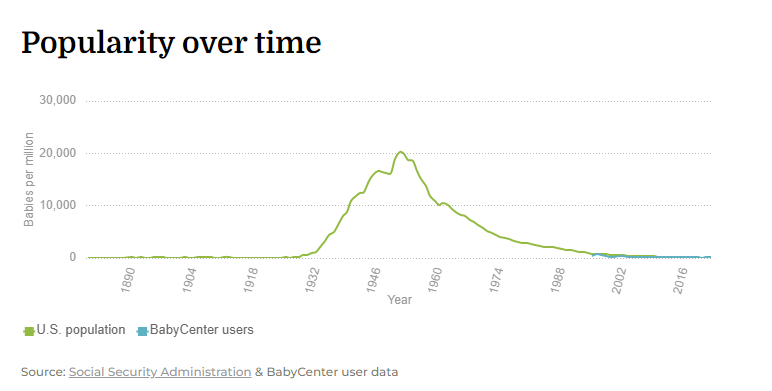Here’s Something About Gary
In 1987, Colorado Senator Gary Hart was widely considered the frontrunner for the Democratic nomination for President. After allegations that he was having an extramarital affair emerged, his popularity tanked and his hopes of winning that election dwindled. And with that, so did almost all hopes for Gary — any Gary — of ever becoming President of the United States.
Why? Because the first name “Gary” is going away — and probably shouldn’t have ever existed.
Let’s start with a graph, below, via BabyCenter.

That graph shows the popularity of the first name “Gary” in the United States over the last 125 years or so, primarily using data from the Social Security Administration. (If you want to look up other names, you can on the SSA’s website, here.) Before 1928, the number of baby boys named Gary hovered around 100 per one million (0.01%, if I did the math right, which is 50/50). But starting in the late 1920s, the popularity of “Gary” began to rise. In 1932, the rate of Gary babies was 1,240 per million, more than 10 times the standard rate just a few years earlier. In 1940, “Gary” was hit 10,844 per million — that’s 1% of all baby boys born that year — and it still had room to grow. In 1954, more than 2% of all baby boys born in the U.S. were named Gary. That year, Gary was the 9th most popular name for a boy born in the United States.
And then, as you can see on the graph above, the name’s popularity started to wain. According to the Society Security Administration, in the year 2021 (last year, for those who, like me, can’t remember what year it is half the time) only 252 baby boys were given the name Gary in the United States, constituting 0.14% of all baby boys born that year.
So where did Gary come from? And why is it going away?
In 1901, a boy named Frank Cooper was born in Helena, Montana. Five years later, the United States Steel Corporation opened up a steel mill in Indiana and named it Gary Works, after the company’s founder, an industrialist named Elbert Herny Gary. The people there formed the city of Gary, Indiana, also named after the industrialist.
About two decades later, Frank Cooper from Helena would meet a woman named Nan Collins from Gary. Cooper was a fledgling actor who was finding some success in silent movies, but he had a problem — there were other Frank Coopers in Hollywood, and he needed to set himself apart. Nan Collins was his agent, and she suggested he change his name to something distinct and came up with an easy-enough idea –he should take her hometown’s name as his own. Cooper agreed and adopted the stage name “Gary Cooper.” (He’d make the change official in 1933.)
Shortly thereafter, Gary Cooper’s career took off. In 1929, he starred in his first non-silent motion picture, The Virginian, Eight years later, he received his first Academy Award nomination, for Mr. Deeds Goes to Town. He won his first Best Actor Oscar in 1942 for Sergeant York and was nominated in the category in each of the following two years. And in 1953 — one year before the name “Gary” peaked in the United States — Gary Cooper won his second and final Academy Award. He dominated the screen for decades until he passed away in 1961.
Cooper’s popularity is widely credited for the boom in Gary babies — it’s not a coincidence that the chart above correlates to his rise in stardom. And as Gary Cooper’s first name wasn’t a first name before he adopted Gary, Indiana’s name as his own, almost all Garys are, indirectly, named after that city in Indiana.
Unfortunately for the Garys out there, few of the children who took on Cooper’s adopted name reached similar stardom. While there are plenty of famous Garys — Oldman, Carter, Coleman, and Spongebob’s snail friend, to name a few — none of them dominated the public discourse like Gary Cooper did. Maybe if Gary Hart had won that Presidential election, the story would be different, but it looks like the first name Gary will only be around for about a century.
Bonus fact: As of 2013, roughly a third of all homes in Gary, Indiana were unoccupied and falling into disrepair. To combat urban blight, the city condemned many of the houses and took ownership of them — and then sold them to residents for the low price of $1. Yes, one dollar. As the New York Times explained, that June, the city planned to “offer Gary residents a chance to pay less for a house than for their morning coffee, as long as they meet a minimum income threshold (starting at $35,250 for one person) and demonstrate the financial ability to bring the neglected property up to code within six months. Those selected would have to live in the home for five years before receiving full ownership.” As of 2018, there were 11 homes for sale as part of the program, and it probably wasn’t a successful idea; the program shut down the next year.
From the Archives: Wendy: The story of that name.
